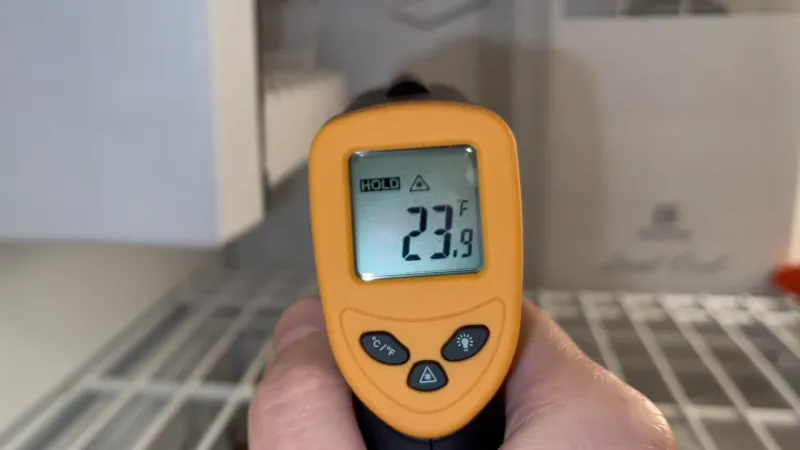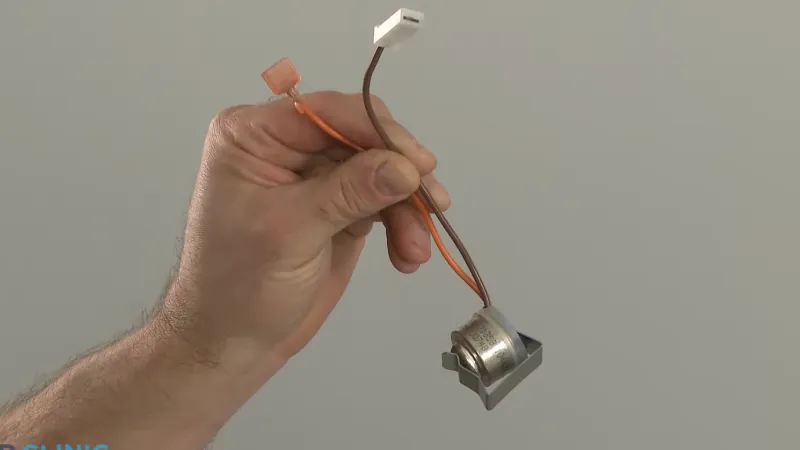GE Profile Refrigerator Temperature Problems and Solution
GE Profile refrigerators are known for their stylish design and advanced features. They provide a convenient way to store and preserve food and drinks, but sometimes they face temperature control problems.
Maintaining the correct temperature inside a refrigerator is crucial to keep the food fresh and safe to consume. Common temperature control problems in GE Profile refrigerators include incorrect temperature settings, opened freezer door, malfunctioning temperature control board or thermostat, and internal cooling issues.
In this blog, we will explore these problems in detail and provide solutions to help you fix them.
You'll Learn About
Ge Profile Refrigerator Problems Temperature
GE Profile refrigerators can sometimes face temperature control problems, leading to incorrect temperature readings or poor cooling performance. Some common causes of temperature problems in GE Profile refrigerators include incorrect temperature settings, opened freezer doors, malfunctioning temperature control boards or thermostats, and internal cooling issues.
To fix these problems, one may need to adjust the temperature settings, close the freezer door, replace a malfunctioning component, or reset the refrigerator. The recommended temperature for a GE refrigerator is 37°F, but it may vary depending on the model.

The temperature control of a GE refrigerator can be found in different locations, such as the back of the fridge section or the ceiling of the fridge, or at the brink of the door in French door models.
Incorrect Temperature Settings
Incorrect temperature settings are a common problem in GE Profile refrigerators. If the temperature inside your refrigerator is not what you set it to, the food inside may spoil, or the unit may not be energy efficient. The incorrect temperature can cause the freezer to defrost, or it may not be cold enough to keep the food fresh.
Causes of Incorrect Temperature Settings
There are several reasons why your GE Profile refrigerator may have incorrect temperature settings. Some common causes include a malfunctioning thermostat, a damaged temperature control board, a clogged condenser, or a problem with the compressor. Sometimes, incorrect temperature settings are also caused by a lack of proper ventilation, which can prevent the unit from maintaining the desired temperature.
How to Fix the Problem
Fixing incorrect temperature settings in a GE Profile refrigerator can be simple or complex, depending on the cause. Here are some steps you can take to resolve the problem:
Check the Thermostat
If the thermostat is damaged, it may not be able to accurately measure the temperature inside the refrigerator. You may need to replace the thermostat to resolve this problem.
General Electric Refrigerator Problems and Solutions
Inspect the Temperature Control Board
If the temperature control board is damaged or malfunctioning, it may not be able to control the temperature of the unit. Replacing the temperature control board should resolve this problem.
Clean the Condenser
A clogged condenser can prevent the refrigerator from cooling properly. Cleaning the condenser should resolve this problem.

Check the Compressor
If the compressor is damaged, it may not be able to cool the unit properly. Replacing the compressor may be necessary to resolve this problem.
Ensure Proper Ventilation
Make sure there is enough space around the refrigerator for proper ventilation. This can help prevent incorrect temperature settings caused by a lack of proper ventilation.
incorrect temperature settings in a GE Profile refrigerator can be caused by various issues. If you’re having trouble with the temperature control, try the above solutions to resolve the problem. If the issue persists, it’s best to seek professional help to avoid further damage to the unit.
Opened Freezer Door
A common problem with GE Profile refrigerators is the temperature display being blank. This can occur if the freezer door has been left open for an extended period of time. When the door is open, warm air enters the freezer, causing the temperature to rise and the cooling system to work harder to maintain the desired temperature.
This can cause the temperature display to shut off.
GE Refrigerators Problems and Solutions
Causes of an Open Freezer Door
The most common cause of an open freezer door is simply forgetting to close it properly. It can also be caused by a faulty door gasket, which allows warm air to enter the freezer even when the door is shut. A malfunctioning door switch, which is responsible for telling the refrigeration system when the door is open or closed, can also be a cause of an open door problem.
How to Fix the Problem
If the display is blank, check to make sure the freezer door is closed correctly. If it was left open, simply close it and wait for the temperature display to return. If the door is closing correctly but the display still won’t turn on, check the door gasket for damage or replace it if necessary.
If the door switch is malfunctioning, it will need to be replaced. If the problem persists, it may be a more serious issue with the refrigeration system and a professional repairman should be consulted.
Malfunctioning Temperature Control Board or Thermostat
A malfunctioning temperature control board or thermostat can cause temperature control problems in GE Profile refrigerators. The temperature control board is responsible for managing the cooling system, while the thermostat monitors the temperature inside the refrigerator and communicates with the control board to ensure the desired temperature is maintained. If either of these components malfunctions, the refrigerator may not be able to maintain the correct temperature.

Causes of a Malfunctioning Temperature Control Board or Thermostat
There are several reasons why the temperature control board or thermostat may malfunction. A power surge or lightning strike can damage the board, while a faulty wiring connection or a bad temperature sensor can cause problems with the thermostat. In some cases, the control board or thermostat may simply wear out over time and need to be replaced.
How to Fix the Problem
To diagnose the problem, it is important to first unplug the refrigerator and check the wiring connections. If they appear to be in good condition, the control board or thermostat should be replaced. This is a relatively straightforward process for a competent do-it-yourselfer, but if you are unsure of your ability to complete the repair, it is best to consult a professional.
sGE Side by Side Refrigerator Freezer Problems and Recall
it is important to take proper care of your GE Profile refrigerator to avoid temperature control problems. If you are experiencing issues with temperature control, checking the settings, door gasket, door switch, temperature control board, or thermostat can help diagnose the problem and get your refrigerator back to functioning properly.
Internal Cooling Issues
A GE Profile refrigerator that is not cooling properly can be a frustrating issue. If the temperature inside the refrigerator is warm, it can cause food to spoil and create an unpleasant odor.
Ice Maker Problems in French Door Refrigerators and Solutions
This can be a sign of an internal cooling issue, which may have a few different causes.
Causes of Internal Cooling Issues
There are several factors that can contribute to internal cooling issues in a GE Profile refrigerator. One common cause is a clogged or dirty condenser coil, which can prevent the refrigerator from efficiently releasing heat.
Another cause could be a malfunctioning fan, which circulates air within the refrigerator and helps maintain a stable temperature. A faulty compressor can also lead to internal cooling issues, as the compressor is responsible for pumping refrigerant and facilitating heat transfer.
How to Fix the Problem
To resolve internal cooling issues, you should first unplug the refrigerator and clean the condenser coils. If this does not resolve the issue, you can check the fan to see if it is functioning correctly.
If the fan is working, you may need to have the compressor inspected by a professional. If the compressor is faulty, it will need to be replaced. If you are not comfortable working with refrigerators, it is best to consult with a professional to diagnose and resolve the problem.
Recommended Temperature for Ge Profile Refrigerators
The recommended temperature for a GE Profile refrigerator is between 37-42°F (3-5°C) for the fridge and 2-8°F (-16 to -13°C) for the freezer. This temperature range ensures that the food stored in the fridge stays fresh and that the freezer keeps the food frozen. It is important to set the temperature correctly to avoid spoilage or damage to the food.
Factors Affecting the Recommended Temperature
The recommended temperature can be affected by various factors such as the ambient temperature, the number of times the door is opened, the placement of the fridge, and the load on the fridge. If the ambient temperature is high, the fridge may have to work harder to maintain the temperature, and this can cause the temperature to fluctuate.
French Door Refrigerator Problems and Solutions
How to Set the Temperature Correctly
To set the temperature correctly, locate the temperature control panel on your GE Profile refrigerator. This may be located in the back of the fridge section or on the ceiling of the fridge. Adjust the temperature to the recommended range, and give the fridge 24 hours to stabilize.
If the lights are still flashing after 24 hours, reset the fridge by unplugging it for 30 seconds.
the recommended temperature for a GE Profile refrigerator is an important factor in ensuring that the food stored in the fridge stays fresh and that the freezer keeps the food frozen. To ensure that the temperature is set correctly, it is important to take into account the ambient temperature and other factors that may affect the temperature, and to adjust the temperature as necessary.
Conclusion
GE Profile refrigerators are popular and reliable appliances, but they can still experience temperature control problems. Incorrect temperature settings, an open freezer door, malfunctioning temperature control board or thermostat, and internal cooling issues are some of the common problems that can affect the temperature of your refrigerator.
Setting the temperature correctly, as per the recommended temperature, is crucial to ensure the longevity and efficiency of your refrigerator. Regular monitoring and maintenance of your GE Profile refrigerator can help avoid these problems and ensure that your food stays fresh and safe.
In this article, we have provided detailed information on these common GE Profile refrigerator temperature problems and how to fix them. By following the outlined steps, you can easily resolve these problems and enjoy the benefits of your GE Profile refrigerator for years to come.

